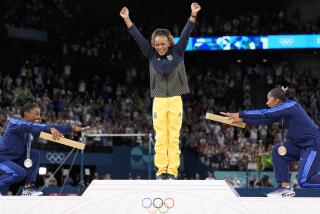Olympics Viewing Flies Off of Ski Jump
- Share via
Concern that the Olympics mean relatively little to younger viewers who came of age after the Cold War has been in part dispelled by the current Winter Games, which are scoring across-the-board gains in various age groups--though they continue to perform disproportionately well among older viewers.
Buoyed by record-breaking tune-in for last week’s opening ceremony, overall viewing of the Games is up 29% compared with the first six days of the 1998 Winter Olympics in Nagano, Japan.
While still less than halfway through the Games’ 17-day run, results have exceeded NBC’s projections and vaulted the network into first place for the season. An estimated 32.7 million people in the U.S. are viewing at any given minute--more than 21/2 times the network’s weekly levels for regular prime-time programming.
That said, the Olympics remain most popular among those over 50. So far, viewers 50 and older--who represent just under 30% of the total U.S. audience--account for 45% of those watching the Games, based on Nielsen Media Research data, about on par with the percentage from the two previous Winter Olympics.
By way of comparison, NBC’s prime-time profile this season, excluding the Olympics, is slightly younger, with adults over 50 constituting 42% of the network’s audience.
In addition, ratings have been less spectacular on non-skating nights, so much so that NBC initiated what competitors say amounts to a scheduling trick to manipulate its ratings. Because more viewers gradually tune in as the night drags on, NBC has begun running its first half-hour of coverage without commercials so that it can be omitted from the network’s overall average. NBC intends to follow that pattern on six additional nights.
An NBC spokeswoman said the network did the same during the Summer Olympics from Sydney, Australia, and that the practice is “completely legitimate,” so long as Nielsen is notified in advance.
Given the Olympics’ somewhat older demographic skew, more youth-oriented programs on competing networks--from Fox’s “That ‘70s Show” to the WB’s “Smallville”--have generally weathered the Olympic challenge best. ABC and CBS, meanwhile, have in some instances bowed to the Games by scheduling reruns or movies in place of original series episodes.
Higher ratings versus the ’98 Olympics can be attributed to various factors, including a renewed patriotism, the fact that the Games originate on U.S. soil and that portions are being broadcast live in much of the country, though not on the West Coast.
NBC has also tailored its coverage to attract a younger audience. As a result, events such as snowboarding and the freestyle skiing moguls have received significant attention, contributing to heightened viewing by adults 18 to 34 and teens, with the network experiencing 31% and 23% growth, respectively, within those age brackets.
Such audience breakdowns have implications for the Olympic movement as well as the Games’ appeal to sponsors, since most media buys are predicated on the number of adults under 50. In general, advertisers place the most emphasis on reaching young adults, hoping to establish brand loyalty among consumers who might purchase their products for years to come.
NBC says that more than 150 million people--or over half of U.S. residents--have thus far watched at least some of its coverage.
More to Read
The biggest entertainment stories
Get our big stories about Hollywood, film, television, music, arts, culture and more right in your inbox as soon as they publish.
You may occasionally receive promotional content from the Los Angeles Times.










